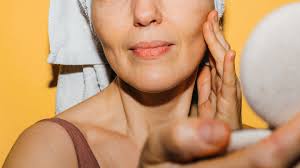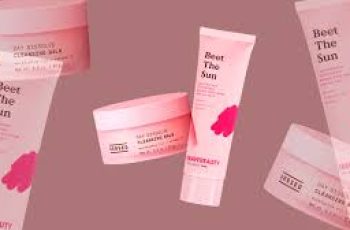
‘Ozempic Face’: How Weight Loss Changes the Skin, and the Treatments That Can Help
Ozempic, a type 2 diabetes medication, has picked up plenty of steam on social media as a weight loss trend. Sudden demand has led to shortages of the prescription-only drug and its obesity treatment counterpart Wegovy. But using it may lead to “Ozempic face.” The term, coined by Paul Jarrod Frank, MD, a New York City–based dermatologist, refers to a side effect of the drug and of rapid weight loss in general: facial aging, including gauntness and skin sagging.
David Shafer, MD, a plastic surgeon in New York City, argues that “Ozempic face” is a term coined for media shock value and attention but, at its root, is nothing new. “As we age and when we lose weight, often we also lose weight in our face, leading to skin laxity,” Dr. Shafer says. “This is not anything specific to Ozempic. Any method of weight loss would lead to the same issue.”
Ozempic Weight Loss Skin Changes Explained
Michele Koo, MD, a plastic surgeon in St. Louis, says significant weight loss (often 35 or more pounds) in a short time period (usually six months or less) depletes the skin and body of essential nutrients and can disrupt the endocrine and GI system homeostasis, or balance.
“The skin thins, [and] loses its elasticity and luster from sudden and rapid depletion of the essential fatty acids that make up the skin barrier function,” she says. “Its collagen and elastin metabolism is also disrupted, resulting further in sallow, dull, thin skin.” Loss of volume, or fat, in the malar and submalar areas — that is, the cheeks — also follows rapid significant weight loss.
The skin changes are primarily from nutrition and vitamin depletion over a short period of time, Dr. Koo adds. “Fat is reabsorbed and atrophies, furthering the aged, gaunt look.”
“Imagine a balloon full of air. If you let a little bit of air out, the balloon is still tight. However, as more and more air is released, the balloon becomes loose, and the elasticity of the balloon cannot compensate for the loss of air volume,” Shafer says. A similar effect happens with the body and face. “With fluctuations in weight, our skin can compensate by stretching and recoiling due to the elastin fibers at the cellular level. As we age, our capacity to contract decreases, and we also lose volume, leading to skin laxity.”
With age especially, but also with weight loss, lips can lose some of their fatty tissue bulk, adds Shafer. “This gives them a dehydrated or shrunken appearance.”
Some people who have facial fullness like losing some of the volume in their face, says Nazanin Saedi, MD, the department co-chair of the laser and aesthetics surgery center at Dermatology Associates of Plymouth Meeting in Pennsylvania. (One current dermatology trend is buccal fat removal, which aims to get rid of baby fat in the cheeks and can give patients a thinner face that some may consider gaunt.) Other people don’t like losing volume in this part of the body because it makes them appear older.
If weight loss was your goal, you may be at peace with the way your skin has since changed, whether you have “extra skin” on your face or stretch marks on your belly, for example. But if you’re dissatisfied with the way your skin looks now, the good news is that a variety of treatments — ranging from over-the-counter products to noninvasive and invasive professional procedures — can help.
Ozempic Face: Before and After Photos
OTC Remedies for Improving Ozempic Face After Weight Loss
If you’re looking to improve skin appearance after using Ozempic to lose weight, Shafer recommends the following:
A healthy diet
Proper hydration
Not smoking
Protection from harmful sun rays
Unfortunately, there are no over-the-counter, or OTC, solutions for replacing facial volume, says Kathleen C. Suozzi, MD, an associate professor of dermatology at Yale School of Medicine in New Haven, Connecticut, and the director of the aesthetic dermatology program at Yale Medicine. “Treatments that support healthy, supple skin may offset the aging effects of volume loss but cannot lift or fill the face.”
Dr. Saedi says the most efficient OTC treatment for aging skin is a retinoid. “Retinoids help improve the skin texture and improve the appearance of crepey skin,” she says.
Shafer also suggests a medical-grade skin-care regimen with bioactive ingredients like tretinoin, a retinol derivative.
When to See a Plastic Surgeon or Dermatologist About Ozempic Face
If OTC products aren’t reversing unwanted skin laxity from weight loss, consider consulting a professional.
“Plastic surgeons and dermatologists are skin and body experts,” says Shafer, who provides surgical and noninvasive skin treatments at Shafer Clinic. “When a patient has concerns that traditional home care, diet, and exercise aren’t addressing, it’s time to see a doctor.”
In-Office Treatments for Ozempic Face After Weight Loss
Various treatments can help improve your skin after weight loss, and the right approach for you depends on your needs.
Dermal Fillers
Juvéderm and Restylane Dermal filler is one of the most effective and instant fixes for loss of volume as a result of facial weight loss, Shafer says. Of those, hyaluronic acid fillers, including Juvéderm and Restylane, are the most popular. There are a few different types of dermal filler.
For the cheeks, Shafer suggests Juvéderm Voluma XC, and for the jawline, he recommends Juvéderm Volux XC, which are both approved by the U.S. Food and Drug Administration (FDA) for adding volume to these specific areas.[1][2] (Volux is the only FDA-approved hyaluronic acid filler for the jawline.)
“While these are not permanent fixes, the dermal fillers, when injected by experienced injectors, can give very nice and natural results,” Shafer says.
The FDA approved Restylane Contour for the midface and cheeks in 2021 and Restylane Lift in 2018 for cheek augmentation and correction of age-related midface contour deficiencies.[3][4]
Results from these types of fillers can last between six months and two years, “but ‘lasting’ does not mean the full effect is present for the entire time,” Shafer notes. “If a filler is said to last two years, I suggest topping up after one year. So, if you did two syringes to reach your full effect during your initial treatment, then you may need one syringe annually to maintain the results. Everyone’s body metabolizes differently, so patients need to understand that a filler may last longer or shorter in different people.”
According to the American Society of Plastic Surgeons, the average cost of hyaluronic acid filler, including Juvéderm and Restylane, is $684 per syringe.[5] But facial fillers “aren’t a beauty procedure in which you can expect to find a low price for a job well done,” argues Shafer, so you shouldn’t try and bargain shop. “The dermal fillers are a tool, but going to a board-certified provider that you’ve researched can determine the outcome.”
Calcium Hydroxylapatite (Radiesse) and Poly-L-Lactic Acid (Sculptra) These are two other dermal fillers. Per Shafer, Radiesse and Sculptra differ from the more popular hyaluronic acid fillers Juvéderm and Restylane.
“Radiesse has gel microspheres, which add volume but also stimulate natural collagen,” he says. It is most similar to hyaluronic acid fillers in that dermatologists can use it for pinpoint injections and definition. The effects last one to two years.
Sculptra, which can take several sessions to see final results, “also works by stimulating natural collagen production under the skin,” he says. Sculptra can last two to three years once you meet your goals and is better for generalized filling than Radiesse.
“The cost will depend on how much you do and how many treatment sessions you need to obtain your ideal results,” says Saedi. These typically are about $1,000 per syringe, and patients will need multiple syringes each visit.
Lasers and Energy Based Devices
Genius Radiofrequency Microneedling Radiofrequency is a newer energy technology, and fractionated radiofrequency, such as Genius, is even newer.[6] The FDA approved it in 2019 to treat the face and body, says Shafer.[7]
Here’s how radiofrequency microneedling works: “Small needles pierce the skin and send energy below the surface to stimulate collagen and tighten the skin,” he says. “The microneedles penetrate and reach the deeper levels that lasers can’t treat.”
While one treatment usually produces the desired results, two to three treatments may be necessary. Prices typically start at $3,500 but vary by treatment area and often have discounts as part of a package.
Fractionated CO2 Resurfacing Shafer calls CO2 lasers “the workhorse for skin tightening” because they have more than 100 FDA-cleared uses that can be performed in 10 medical specialties, including dermatology, plastic surgery, and gynecology. The FDA approved CO2 lasers in 2004.[8] Although downtime can be up to two weeks long, as these lasers treat the superficial layers of the skin, “the results can be substantial on fine lines and pigmentation,” Shafer says.
Prices start at $3,500 and vary depending on body area and skin laxity; most people need one treatment per year. “Also, patients need to be prepared for longer recovery time than technologies that focus the energy deeper,” he says, adding that combining treatment modalities can yield better results than just one type of treatment. “It is also important to note that energy-based skin tightening, including CO2 lasers, is not equivalent to surgical skin tightening. Energy treatments cannot match the degree of tightening achievable with surgical excision.”
Ulthera or Sofwave (Microfocused Ultrasound) The FDA approved Ulthera in 2014 to lift the eyebrow, chin, and neck area, as well as improve lines and wrinkles in the low neckline or décolleté.[9] Sofwave has been FDA-cleared since 2020 to improve fine lines and wrinkles on the face and neck, and in 2021 got a new indication for lifting areas around the eyebrow and neck, as well as under the chin.[10] The treatment has since received FDA approval for treating skin laxity on the upper arm, according to a press release from Sofwave.[11]
Shafer says microfocused ultrasound treatments like these use ultrasound energy to stimulate the formation of collagen below the skin’s surface. Producing collagen takes time, so results can become more apparent over two to three months or sometimes up to six months.
The procedure takes about 30 to 90 minutes, depending on the area treated, and there is no downtime afterward. Treatments start at $2,000 but vary by body area. “The majority of patients only need one treatment. However, some may benefit from more than one treatment, depending on how much skin laxity they have and their body’s own biological response to the ultrasound and the collagen-building process,” he says.
Follow-up Ultherapy or Sofwave treatments each year may help maintain results.
Other Skin Treatments After Weight Loss
Renuvion The FDA approved this treatment, which uses helium plasma energy to tighten skin in the neck area, in 2022.[12]
The one-time treatment is performed under the skin through tiny incisions under local anesthesia; the recovery time is moderate, ranging from one to three weeks. “When a medical professional applies this treatment under the skin during a liposuction procedure, the plasma energy helps enhance skin tightening in the neck and throughout the body.
“When applied externally, the skin tightening is stimulated by the plasma energy,” Shafer explains. “Generally, each area only needs to be treated once, but the body continues to age as with any treatment. So the treatment does not stop the aging clock, but helps reverse it as time keeps going by,” he notes. The average cost is around $6,000.
The FDA has also approved a separate device, the Renuvion Dermal Handpiece, for treating moderate to severe wrinkles and rhytides in patients with Fitzpatrick Skin Types 1, 2, or 3. These are skin types more likely to burn than tan.[12]
Fat Transfer Per Koo, fat transfer is another option to plump up the face after rapid weight loss. This procedure involves removing fat from the hips or abdomen, cleaning for any remnant bloody debris, and reinjecting it into the cheeks, under the eyes, around the lips, and in or around the chin, mouth, or temple areas. “Plastic surgeons can place fat anywhere there is a deficit. Certain areas (under the eyes) require tiny amounts spread out over the entire area due to the risk of fat embolism and awkward distortion,” she explains.
Fat injections for the face are best done a few cell layers at a time, as a thin layer increases the likelihood of cell survival. Therefore, depending on how many areas and which areas are treated, along with how much fat the surgeon is transferring, several sessions may be necessary. Koo explains that another benefit of transferring fat a little at a time is it ensures a slower, more gradual change in volume instead of a one-time large expansion, “which can distort and drastically change facial shape in a very short time,” she says.
“You don’t want to obliterate the normal anatomy. Instead, you want a soft-plumped version of yourself, not a blown-up one. Prices vary by region, but you can expect to pay $2,500 to $10,000 per treatment, depending on the volume of the injection. For example, delicate areas around the eyes or nose take more time, finesse, and care due to higher risks, so expect to pay more.”
Face Lift or Neck Lift For people in their late fifties and sixties, filler may not be enough, and volume replacement may require plastic surgery, Dr. Suozzi says. Plastic surgery can be performed almost anywhere on the face and body to address post–weight loss skin woes.
Shafer adds that facelifts and neck lifts are the next steps. “During this surgical procedure, the surgeons tights the underlying muscle, repositions and sometimes augments the underlying fat, and then tightens the skin,” he says. “Patients are often pleasantly surprised at the recovery and dramatic but natural-appearing results.”
Prices can vary from $25K to more than $100K, depending on the extent of the procedure and who is performing it. Where you’re receiving the treatment can also affect pricing. The biggest pro is that the results are long-lasting.
Summary
While losing weight fast may seem appealing, Suozzi suggests keeping in mind that any form of rapid weight loss can cause the appearance of accelerated facial aging. “These are effects from loss of facial fat, not changes in the skin,” she says. Rapid weight loss can also result in skin sagging on other parts of the body, including the neck and arms.
Some people who have facial fullness like losing some of the volume in their face, Saedi points out, citing buccal fat removal. “Many celebrities, including the Kardashians and Chrissy Teigen, have been very public about having their buccal fat pads (submalar fat) removed to achieve a more angular, refined look versus a round facial look,” Koo says.
If you do decide to invest in alternative options, the most important thing is to find a board-certified plastic surgeon or dermatologist to get the job done right, even if you have to invest a little more money, Shafer advises.


